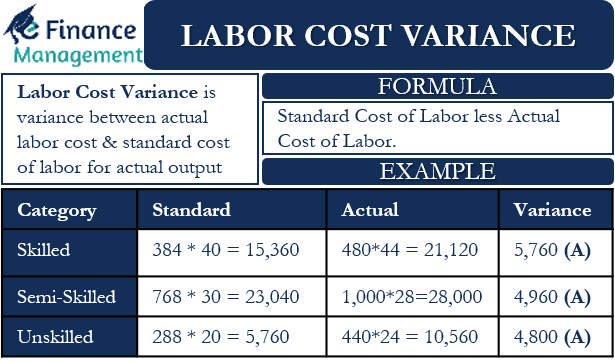Labor Cost Variance is the difference between the standard cost of labor for the actual output and the actual cost of labor for the production. We can also call this variance wages variance or LCV. Like other types of variance, the LCV can be favorable or unfavorable.
So, the formula or equation to calculate the LCV is :
= Standard Cost of Labor less Actual Cost of Labor.
Since labor costs are usually given in the number of hours, so the formula to calculate the standard and actual labor cost is:
Standard Labor Cost: Standard Labor Hours for the actual Production*Standard Labor cost per hour.
Actual Labor Cost: Actual Labour Hours are used for the actual production*actual labor cost per hour.
Example of Labor Cost Variance
Here we will take up one example for better understanding and clarity about the calculation for Labor Cost Variance.
Company A estimates that it could produce 15,000 units of X using 400 hours of skilled labor, 800 hours of semi-skilled labor, and 300 hours of Unskilled labor. The standard cost of the three types of labor is $40, $30, and $20, respectively.
In reality, Company A was able to produce 14,400 units of X using 480 hours of skilled labor, 1000 hours of semi-skilled labor, and 440 hours of Unskilled labor. The actual cost of the three types of labor is $44, $28, and $24, respectively.
To calculate the LCV, we first need to find the standard labor hours for the actual output.
For this, we need to multiply the standard labor hours by the ratio of Actual output and standard output.
This ratio will = 14,400/ 15,000 = 0.96

Now, the standard skilled labor hours for the actual output will be = 400 * 0.96 = 384
The standard semi-skilled labor hours for the actual output will be = 800 * 0.96 = 768
The standard unskilled labor hours for the actual output will be = 300 * 0.96 = 288
Now, we will calculate the Labor Cost Variance for each type of labor.
The LCV for Skilled labor = (384 * $40) less (480 * $44) = $15,360 less $21,120 = -$5,760 Adverse
LCV for semi-Skilled labor = (768 * $30) less (1000 * $28) = $23,040 less $28,000 = – $4,960 Adverse
LCV for un-Skilled labor = (288 * $20) less (440 * $24) = $5,760 less $10,560 = – $4800 Adverse
So, total LCV = –15,520 Adverse
Sub-Set of LCV
If we observe in the above example, the total LCV variance consists of two such sub-variances – Labor Hour Variance & Labour Cost Per Hour Variance. In other words, LCV is the combination of differences between the standard and actual cost of labor that can be due to variance in the number of hours and/or price or cost per labor hour.
Labor Hours Variance
This is the variance that happens due to a difference in the actual number of hours worked Vs. the standard number of hours estimated. If we see in the above example, at all stages, the actual number of hours worked is more (480, 1000 & 440) as against the standard hours estimated initially (384, 768 & 288). Therefore, the cost varying to the extent of the excess number of hours worked is the Labor Hours Variance. We may also call it Labor Quantity Variance or Labor Efficiency Variance.
Labor Rate Variance
Now, this is the variance in cost because of the cost per hour actually paid or incurred vs. the estimated cost per hour. Again if we see in the above example, besides the excess number of hours actually worked, the actual price/cost paid per hour was also in excess at two stages (44 vs. 40 and 24 vs. 20 for unskilled workers) and was lower at one stage (28 vs. 30 for semi-skilled workers). Read more about labor rate variance.
Final Words
Labor Cost Variance can be very helpful to a company in making its production efficiency. The calculation and analysis of this variance could provide management with in-depth information on the cause of the variance. They can then take appropriate corrective actions to eliminate or at least minimize the LCV.
Refer to Variance Analysis Formula with Example for various other types of variances.
Frequently Asked Questions (FAQs)
Labor Cost Variance is the variance between the standard cost of labor for the actual output and the actual cost of labor.
The formula or equation to calculate the LCV = Standard Cost of Labor less Actual Cost of Labor.

